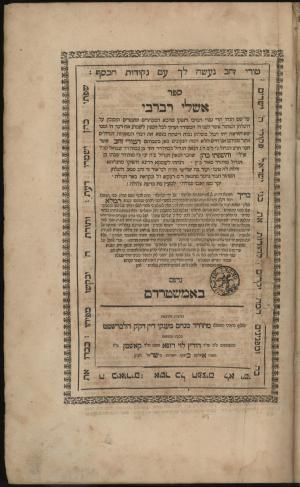Obj. ID: 35575
Jewish printed books Eshlei Ravrevei by Yosef ben Ephraim Karo, Amsterdam, 1743

This text was prepared by William Gross:
The Eshlei Ravrevei is a text of Shulchan Aruch'st Yoreh Deah (the part related to ritual law) by Yosef Karo, with commentaries customarily included therein, including Turei Zahav, Siftei Kohen, and Beer ha-Golah. Yoreh Deah was published earlier as Eshlei Ravrevei in Wilhelmsdorf in 1677 and 1686 , without Moses Rivkes' commentary, but with HaRav Isserles comments, presenting alternative determinations in the spirit of the Ashkenazic tradition.
The frontispiece shows Moses, Aaron, David and Solomon sitting. The symbolize in turn the crown of Torah, priesthood and kingdom and the "crown of a good name that is superior to all these" (Pirkei Avot 4:17). The cooperplate was used earlier at least once by Immanuel Athias in Shnei Luchot ha-Brit, published in 1698. The same artist, Avraham bar Ya'akov, created both the famous illustrations for the Amsterdam Haggadah, as well as the frontispiece for the Yiddish Bible published at the Uri Phoebus press in 1679. He is commonly considered to be a convert from the Rhine area, who reconverted to Judaism only in Amsterdam.
As indicated on the title page, the printers Naftali Hertz Levi Rofe and Kosman ben Yosef were father-in-law and son-in-law. Naftali Hertz ben Alexander Ziskind Levi Rofe of Emden set up his press in Amsterdam in 1726. He complemented his printing equipment with that purchased from the Isaac Templo press after it was closed down. He was a physician by profession, as evidenced by his moniker Rofe. He was granted title of doctor of medicine from the University of Harderwijk in 1716. He pursued his medical practice, as well as printing and bookselling. He tended to publish alone as well as in cooperation with others, but above all with his son-in-law Kosman ben Joseph Baruch, who was also involved in the book trade. Their cooperation lasted from 1742 to 1766, and resulted in many works being jointly published. Kosman eventually ceased printing with his father-in-law, and continued instead with his son.
This title page was also used on the earlier edition of Eshlei Ravrevei from 1711, also in the Gross Family Collection (B.246).





